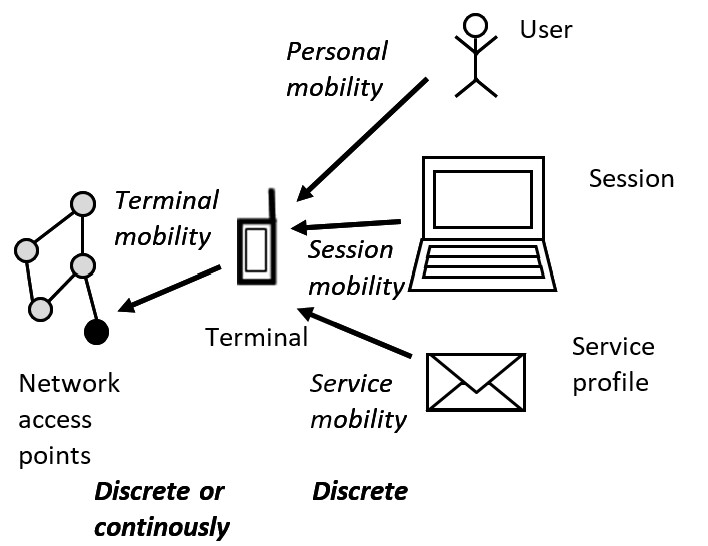1 Mobility
Conditions d’achèvement
1 Mobility
Mobile communication – as stated by the name – faces mobility. From mobility, consequences arise, influencing other network components. But what exactly is mobility?
The term mobility is vital for the understanding of mobile networks. Many new features arise from the necessity to cope with mobility. There are different kinds of mobility that address physical whereabouts of mobile terminals and logical allocation. In former networks the only mobility implemented was
Terminal mobility can be as well discrete (point-to-point, e.g. ISDN network) as continuous (e.g. GSM network). There are as well hybrid forms, where continuous mobility is available at certain locations. Continuous mobility almost always needs a radio link or connection between a network access point and a user equipment. The other kinds of mobility are discrete, based on logical assignment of links, states, and information to special user equipment. Therefore, data has to be stored. Figure 1-1 shows an overview of mobility.

Figure 1-1: Mobility.
Mobility always consists of two components: variant and invariant. The variant enables mobility in a certain dimension; the invariant enables a fixed assignment independent of the mobility. Table 1-1 shows an overview.
The term mobility is vital for the understanding of mobile networks. Many new features arise from the necessity to cope with mobility. There are different kinds of mobility that address physical whereabouts of mobile terminals and logical allocation. In former networks the only mobility implemented was
- terminal mobility
- personal mobility
- service mobility and
- session mobility
Terminal mobility can be as well discrete (point-to-point, e.g. ISDN network) as continuous (e.g. GSM network). There are as well hybrid forms, where continuous mobility is available at certain locations. Continuous mobility almost always needs a radio link or connection between a network access point and a user equipment. The other kinds of mobility are discrete, based on logical assignment of links, states, and information to special user equipment. Therefore, data has to be stored. Figure 1-1 shows an overview of mobility.

Figure 1-1: Mobility.
Mobility always consists of two components: variant and invariant. The variant enables mobility in a certain dimension; the invariant enables a fixed assignment independent of the mobility. Table 1-1 shows an overview.
Table 1-1: Components of mobility
| Mobility | Variant | Invariant |
|---|---|---|
| Terminal mobility | Location of user equipment | (radio) link |
| Personal mobility | User equipment | Personalized number |
| Session mobility | Time User equipment |
Service session (temporary constellation of services and users) |
| Service mobility | User equipment | Preferred services, service attributes and settings (of the user equipment) |
From Table 1-1 it is obvious, that personal and service mobility are related as they have the same variant. Both are used for personalization of communication services for mobile users. Session mobility and service mobility are similar and are treated together from here on.
